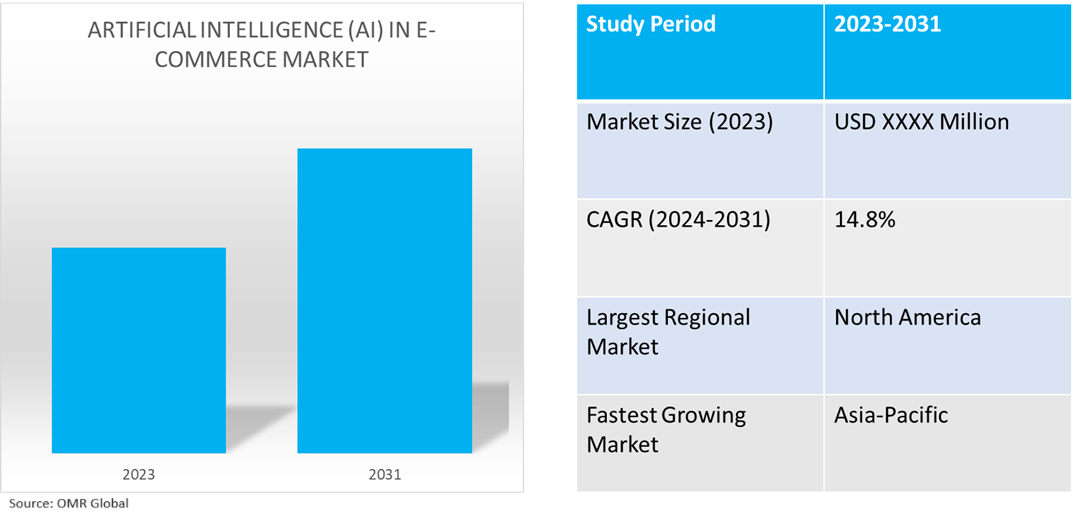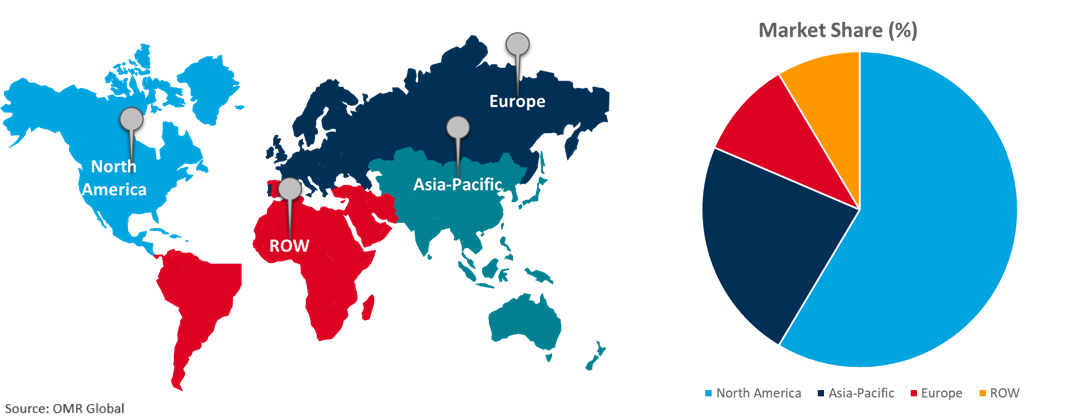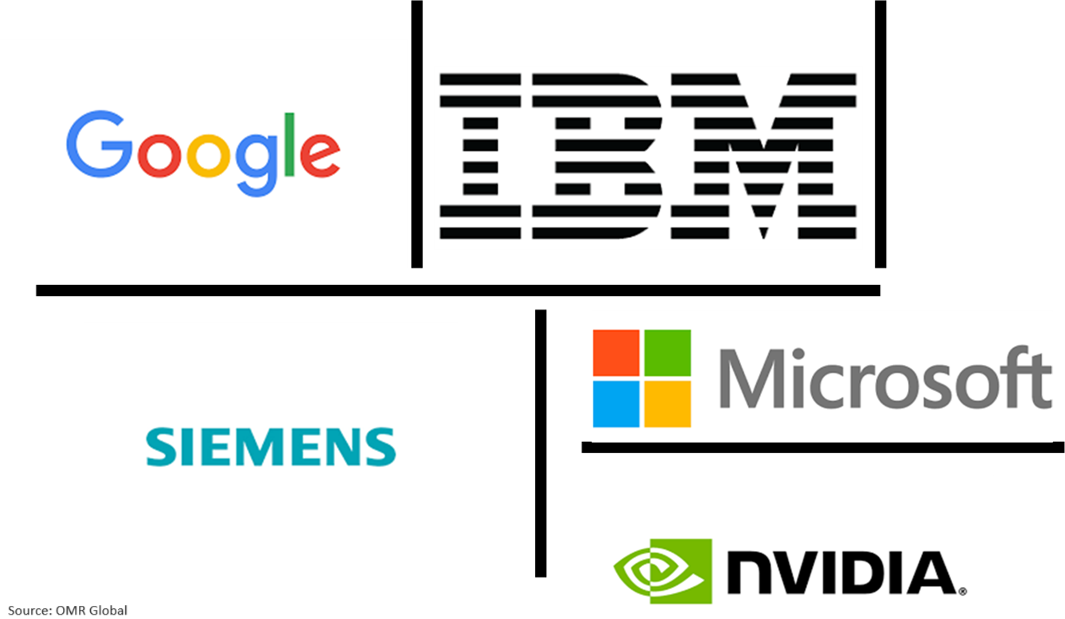AI in Environmental Protection Market
AI in Environmental Protection Market Size, Share & Trends Analysis Report by Component (Software, and Services), by Deployment (On-Premises, and Cloud), and by Application (Energy Management, Water Management, Carbon Footprints Management, Waste Management, and Others), Forecast Period (2024-2031) Update Available - Forecast 2025-2035
Artificial intelligence (AI) in environmental protection market is anticipated to grow at a significant CAGR of 17.3% during the forecast period (2024-2031). According to the World Economic Forum, the use of AI can contribute to the fight against climate change. Existing AI systems include tools that predict the weather, track icebergs, and identify pollution. AI can also be used to improve agriculture and reduce its environmental impact. According to the US Environmental Protection Agency, in February 2024, waste is a big producer of methane and is responsible for 16.0% of global greenhouse gas (GHG) emissions. Greyparrot AI Ltd., a software startup based in London, UK, has developed an AI system that analyzes waste processing and recycling facilities to help them recover and recycle more waste material. The company tracked 32 billion waste items across 67 waste categories in 2022 and it identifies 86 tons of material on average that could be recovered but is being sent to landfill.

Market Dynamics
Growing Demand for AI in Energy Efficiency
By anticipating patterns in energy usage and optimizing energy consumption, artificial intelligence (AI) can assist increase energy efficiency in buildings and industries. In addition, it can pinpoint regions of energy waste and offer solutions for cutting it down. AI has enormous potential to reduce energy use. Tasks can be automated by intelligent robotics, and early defect detection and quality control can be achieved via machine vision. This reduces emissions, wasteful material use, and needless physical labor. By tracking energy usage, AI creates personalized prediction models that forecast patterns of consumption depending on several characteristics, including occupancy, usage, asset type, weather, and time of day. AI recognizes anomalous deviations instantly by forecasting consumption patterns. For instance, Google’s DeepMind has used AI to optimize the cooling systems in its data centers, reducing energy consumption and carbon emissions.
Increasing Adoption of AI to Detect Climate Change
By analyzing data on greenhouse gas emissions, weather patterns, and other environmental aspects, AI can contribute to combating climate change. This can assist in informing strategies and policies aimed at cutting emissions and lessening the effects of climate change. The market players assist in the study and prediction of weather patterns and the effects of climate change in a variety of applications, such as climate modeling and weather forecasting. For instance, in November 2023, IBM and NASA are building an AI foundation model for weather and climate. The goal is to improve the speed, accuracy, and accessibility of weather forecasting and other climate applications.
Market Segmentation
- Based on the component, the market is segmented into software and services.
- Based on the deployment, the market is segmented into on-premises and cloud.
- Based on the application, the market is segmented into energy management, water management, carbon footprint management, waste management, and others (weather prediction).
Waste Management Segment to Hold a Considerable Market Share
The waste management segment is expected to hold a considerable share of the market. The factors supporting segment growth include the growing AI potential for trash management. AI can dramatically lower the amount of waste dumped in landfills and raise the quantity of items recovered for recycling by improving sorting accuracy. AI usage can improve the network of waste material recovery and enhance the sorting operations of recyclable materials. It also contributes towards meeting the goal of clean and compliant recovery, recycling, and disposal of plastic waste.
For instance, in September 2023, SUEZ and its partner Taichu Environmental Resource Management signed a contract to jointly invest in, build, and operate six collection and sorting centers for post-consumer plastics in Eastern China. The joint venture adopts advanced technologies such as artificial intelligence and intelligent information systems to deliver a smart, digitalized, and low-carbon recovery system, with end-to-end traceability. These facilities are scheduled to be completed by early 2024 and will be able to collect and sort approximately 30,000 tons of plastic waste per year.
Regional Outlook
Global AI in the environmental protection market is further segmented based on geography including North America (the US, and Canada), Europe (the UK, Italy, Spain, Germany, France, and the Rest of Europe), Asia-Pacific (India, China, Japan, South Korea, and Rest of Asia-Pacific), and the Rest of the World (the Middle East & Africa, and Latin America).
Growing Demand for AI in Environmental Protection in Europe
- The regional growth is attributed to pivotal factors such as the increasing negative impact of climate change. According to the European Environment Agency, (EEA), in May 2024, Extreme weather events like storms, heatwaves, and flooding accounted for 85,000 to 145,000 human fatalities across Europe, over the past 40 years. Over 85.0% of those fatalities were owing to heatwaves. Economic losses from weather and climate-related extremes in Europe reached around half a trillion euros over the same period.
- In March 2024, The UK government allocated £1.73 million ($1.87 million) in funding to support innovative AI projects to reduce carbon emissions across critical sectors. The funding, announced as part of the government’s AI for Decarburization Innovation Programme, will trust UK developers to use the potential of AI in revolutionizing energy efficiency, increasing renewables, and decarbonizing key industries.
Global AI in Environmental Protection Market Growth by Region 2024-2031

North America Holds Major Market Share
The market growth is attributed to the increasing demand for sustainable waste management, growing environmental concerns, and the adoption of AI-powered tools to effectively manage carbon emissions in the region. According to the United Nations Environment Programme (UNEP), in February 2024, Municipal solid waste generation is predicted to grow from 2.1 billion tons in 2023 to 3.8 billion tons by 2050. In 2020, the global direct cost of waste management was estimated at $252 billion. When factoring in the hidden costs of pollution, poor health, and climate change from poor waste disposal practices, the cost rises to $361 billion.
Without urgent action on waste management, by 2050 this global annual cost could almost double to a staggering $640.3 billion. The presence of key players that offer zero waste management platforms that use AI for efficiently managing waste management workflows is further driving regional market growth. For instance, in November 2022, the US Environmental Protection Agency (EPA) announced that Zabble, Inc., in Walnut Creek, Calif., received a $400,000 contract to further the development of a zero waste management platform that uses artificial intelligence.
Market Players Outlook

*Note: Major Players Sorted in No Particular Order.
The major companies serving the AI in environmental protection market include Google LLC, IBM Corp., Microsoft Corp., NVIDIA Corp., and Siemens AG. among others. The market players are increasingly focusing on business expansion and product development by applying strategies such as collaborations, mergers, and acquisitions to stay competitive in the market.
Recent Development
- In April 2022, Microsoft Corp. selects AI start-ups to accelerate progress on environmental sustainability. Ten companies focused on reducing carbon emissions and waste, preserving water, and protecting ecosystems have been selected to take part in Microsoft’s AI for environmental sustainability accelerator programme.
The Report Covers
- Market value data analysis of 2023 and forecast to 2031.
- Annualized market revenues ($ million) for each market segment.
- Country-wise analysis of major geographical regions.
- Key companies operating in the AI in environmental protection market. Based on the availability of data, information related to new product launches, and relevant news is also available in the report.
- Analysis of business strategies by identifying the key market segments positioned for strong growth in the future.
- Analysis of market-entry and market expansion strategies.
- Competitive strategies by identifying ‘who-stands-where’ in the market.
1. Report Summary
• Current Industry Analysis and Growth Potential Outlook
1.1. Research Methods and Tools
1.2. Market Breakdown
1.2.1. By Segments
1.2.2. By Region
2. Market Overview and Insights
2.1. Scope of the Report
2.2. Analyst Insight & Current Market Trends
2.2.1. Key Findings
2.2.2. Recommendations
2.2.3. Conclusion
3. Competitive Landscape
3.1. Key Company Analysis
3.2. Google LLC
3.2.1. Overview
3.2.2. Financial Analysis
3.2.3. SWOT Analysis
3.2.4. Recent Developments
3.3. IBM Corp.
3.3.1. Overview
3.3.2. Financial Analysis
3.3.3. SWOT Analysis
3.3.4. Recent Developments
3.4. Microsoft Corp.
3.4.1. Overview
3.4.2. Financial Analysis
3.4.3. SWOT Analysis
3.4.4. Recent Developments
3.5. NVIDIA Corp.
3.5.1. Overview
3.5.2. Financial Analysis
3.5.3. SWOT Analysis
3.5.4. Recent Developments
3.6. Siemens AG
3.6.1. Overview
3.6.2. Financial Analysis
3.6.3. SWOT Analysis
3.6.4. Recent Developments
3.7. Key Strategy Analysis
4. Market Segmentation
4.1. Global AI in Environmental Protection Market by Component
4.1.1. Software
4.1.2. Services
4.2. Global AI in Environmental Protection Market by Deployment
4.2.1. Cloud
4.2.2. On-premises
4.3. Global AI in Environmental Protection Market by Application
4.3.1. Energy Management
4.3.2. Water Management
4.3.3. Carbon Footprints Management
4.3.4. Waste Management
4.3.5. Others (Weather Prediction)
5. Regional Analysis
5.1. North America
5.1.1. United States
5.1.2. Canada
5.2. Europe
5.2.1. UK
5.2.2. Germany
5.2.3. Italy
5.2.4. Spain
5.2.5. France
5.2.6. Rest of Europe
5.3. Asia-Pacific
5.3.1. China
5.3.2. India
5.3.3. Japan
5.3.4. South Korea
5.3.5. Rest of Asia-Pacific
5.4. Rest of the World
5.4.1. Latin America
5.4.2. Middle East and Africa
6. Company Profiles
6.1. Aclima, Inc.
6.2. ARCUBED
6.3. C3.ai Inc.
6.4. Capgemini Services SAS
6.5. CDP Global System
6.6. Envirosuite Ltd.
6.7. GE Vernova Group’s
6.8. Greyparrot AI Ltd.
6.9. Grid4C
6.10. Honeywell International Inc.
6.11. Omdena Inc.
6.12. Orbital Insight
6.13. Planet Labs PBC
6.14. Rezatec (Hexcuity Ltd.)
6.15. SAP SE
6.16. Schneider Electric SE
6.17. Xylem Ltd.
1. GLOBAL AI IN ENVIRONMENTAL PROTECTION MARKET RESEARCH AND ANALYSIS BY COMPONENT, 2023-2031 ($ MILLION)
2. GLOBAL AI IN ENVIRONMENTAL PROTECTION SOFTWARE MARKET RESEARCH AND ANALYSIS BY REGION, 2023-2031 ($ MILLION)
3. GLOBAL AI IN ENVIRONMENTAL PROTECTION SERVICES MARKET RESEARCH AND ANALYSIS BY REGION, 2023-2031 ($ MILLION)
4. GLOBAL AI IN ENVIRONMENTAL PROTECTION MARKET RESEARCH AND ANALYSIS BY DEPLOYMENT, 2023-2031 ($ MILLION)
5. GLOBAL ON-PREMISES AI IN ENVIRONMENTAL PROTECTION MARKET RESEARCH AND ANALYSIS BY REGION, 2023-2031 ($ MILLION)
6. GLOBAL CLOUD-BASED AI IN ENVIRONMENTAL PROTECTION MARKET RESEARCH AND ANALYSIS BY REGION, 2023-2031 ($ MILLION)
7. GLOBAL AI IN ENVIRONMENTAL PROTECTION MARKET RESEARCH AND ANALYSIS BY APPLICATION, 2023-2031 ($ MILLION)
8. GLOBAL AI IN ENVIRONMENTAL PROTECTION FOR ENERGY MANAGEMENT MARKET RESEARCH AND ANALYSIS BY REGION, 2023-2031 ($ MILLION)
9. GLOBAL AI IN ENVIRONMENTAL PROTECTION FOR WATER MANAGEMENT MARKET RESEARCH AND ANALYSIS BY REGION, 2023-2031 ($ MILLION)
10. GLOBAL AI IN ENVIRONMENTAL PROTECTION FOR CARBON FOOTPRINTS MANAGEMENT MARKET RESEARCH AND ANALYSIS BY REGION, 2023-2031 ($ MILLION)
11. GLOBAL AI IN ENVIRONMENTAL PROTECTION FOR WASTE MANAGEMENT MARKET RESEARCH AND ANALYSIS BY REGION, 2023-2031 ($ MILLION)
12. GLOBAL AI IN ENVIRONMENTAL PROTECTION FOR OTHER APPLICATION MARKET RESEARCH AND ANALYSIS BY REGION, 2023-2031 ($ MILLION)
13. GLOBAL AI IN ENVIRONMENTAL PROTECTION MARKET RESEARCH AND ANALYSIS BY REGION, 2023-2031 ($ MILLION)
14. NORTH AMERICAN AI IN ENVIRONMENTAL PROTECTION MARKET RESEARCH AND ANALYSIS BY COUNTRY, 2023-2031 ($ MILLION)
15. NORTH AMERICAN AI IN ENVIRONMENTAL PROTECTION MARKET RESEARCH AND ANALYSIS BY COMPONENT, 2023-2031 ($ MILLION)
16. NORTH AMERICAN AI IN ENVIRONMENTAL PROTECTION MARKET RESEARCH AND ANALYSIS BY DEPLOYMENT, 2023-2031 ($ MILLION)
17. NORTH AMERICAN AI IN ENVIRONMENTAL PROTECTION MARKET RESEARCH AND ANALYSIS BY APPLICATION, 2023-2031 ($ MILLION)
18. EUROPEAN AI IN ENVIRONMENTAL PROTECTION MARKET RESEARCH AND ANALYSIS BY COUNTRY, 2023-2031 ($ MILLION)
19. EUROPEAN AI IN ENVIRONMENTAL PROTECTION MARKET RESEARCH AND ANALYSIS BY COMPONENT, 2023-2031 ($ MILLION)
20. EUROPEAN AI IN ENVIRONMENTAL PROTECTION MARKET RESEARCH AND ANALYSIS BY DEPLOYMENT, 2023-2031 ($ MILLION)
21. EUROPEAN AI IN ENVIRONMENTAL PROTECTION MARKET RESEARCH AND ANALYSIS BY APPLICATION, 2023-2031 ($ MILLION)
22. ASIA-PACIFIC AI IN ENVIRONMENTAL PROTECTION MARKET RESEARCH AND ANALYSIS BY COUNTRY, 2023-2031 ($ MILLION)
23. ASIA-PACIFIC AI IN ENVIRONMENTAL PROTECTION MARKET RESEARCH AND ANALYSIS BY COMPONENT, 2023-2031 ($ MILLION)
24. ASIA-PACIFIC AI IN ENVIRONMENTAL PROTECTION MARKET RESEARCH AND ANALYSIS BY DEPLOYMENT, 2023-2031 ($ MILLION)
25. ASIA-PACIFIC AI IN ENVIRONMENTAL PROTECTION MARKET RESEARCH AND ANALYSIS BY APPLICATION, 2023-2031 ($ MILLION)
26. REST OF THE WORLD AI IN ENVIRONMENTAL PROTECTION MARKET RESEARCH AND ANALYSIS BY REGION, 2023-2031 ($ MILLION)
27. REST OF THE WORLD AI IN ENVIRONMENTAL PROTECTION MARKET RESEARCH AND ANALYSIS BY COMPONENT, 2023-2031 ($ MILLION)
28. REST OF THE WORLD AI IN ENVIRONMENTAL PROTECTION MARKET RESEARCH AND ANALYSIS BY DEPLOYMENT, 2023-2031 ($ MILLION)
29. REST OF THE WORLD AI IN ENVIRONMENTAL PROTECTION MARKET RESEARCH AND ANALYSIS BY APPLICATION, 2023-2031 ($ MILLION)
1. GLOBAL AI IN ENVIRONMENTAL PROTECTION MARKET SHARE BY COMPONENT, 2023 VS 2031 (%)
2. GLOBAL AI IN ENVIRONMENTAL PROTECTION SOFTWARE MARKET SHARE BY REGION, 2023 VS 2031 (%)
3. GLOBAL AI IN ENVIRONMENTAL PROTECTION SERVICES MARKET SHARE BY REGION, 2023 VS 2031 (%)
4. GLOBAL AI IN ENVIRONMENTAL PROTECTION MARKET SHARE BY DEPLOYMENT, 2023 VS 2031 (%)
5. GLOBAL ON-PREMISES AI IN ENVIRONMENTAL PROTECTION MARKET SHARE BY REGION, 2023 VS 2031 (%)
6. GLOBAL CLOUD AI IN ENVIRONMENTAL PROTECTION MARKET SHARE BY REGION, 2023 VS 2031 (%)
7. GLOBAL AI IN ENVIRONMENTAL PROTECTION MARKET SHARE BY APPLICATION, 2023 VS 2031 (%)
8. GLOBAL AI IN ENVIRONMENTAL PROTECTION FOR ENERGY MANAGEMENT MARKET SHARE BY REGION, 2023 VS 2031 (%)
9. GLOBAL AI IN ENVIRONMENTAL PROTECTION FOR WATER MANAGEMENT MARKET SHARE BY REGION, 2023 VS 2031 (%)
10. GLOBAL AI IN ENVIRONMENTAL PROTECTION FOR CARBON FOOTPRINTS MANAGEMENT MARKET SHARE BY REGION, 2023 VS 2031 (%)
11. GLOBAL AI IN ENVIRONMENTAL PROTECTION FOR WASTE MANAGEMENT MARKET SHARE BY REGION, 2023 VS 2031 (%)
12. GLOBAL AI IN ENVIRONMENTAL PROTECTION FOR OTHER APPLICATION MARKET SHARE BY REGION, 2023 VS 2031 (%)
13. GLOBAL AI IN ENVIRONMENTAL PROTECTION MARKET SHARE BY REGION, 2023 VS 2031 (%)
14. US AI IN ENVIRONMENTAL PROTECTION MARKET SIZE, 2023-2031 ($ MILLION)
15. CANADA AI IN ENVIRONMENTAL PROTECTION MARKET SIZE, 2023-2031 ($ MILLION)
16. UK AI IN ENVIRONMENTAL PROTECTION MARKET SIZE, 2023-2031 ($ MILLION)
17. FRANCE AI IN ENVIRONMENTAL PROTECTION MARKET SIZE, 2023-2031 ($ MILLION)
18. GERMANY AI IN ENVIRONMENTAL PROTECTION MARKET SIZE, 2023-2031 ($ MILLION)
19. ITALY AI IN ENVIRONMENTAL PROTECTION MARKET SIZE, 2023-2031 ($ MILLION)
20. SPAIN AI IN ENVIRONMENTAL PROTECTION MARKET SIZE, 2023-2031 ($ MILLION)
21. REST OF EUROPE AI IN ENVIRONMENTAL PROTECTION MARKET SIZE, 2023-2031 ($ MILLION)
22. INDIA AI IN ENVIRONMENTAL PROTECTION MARKET SIZE, 2023-2031 ($ MILLION)
23. CHINA AI IN ENVIRONMENTAL PROTECTION MARKET SIZE, 2023-2031 ($ MILLION)
24. JAPAN AI IN ENVIRONMENTAL PROTECTION MARKET SIZE, 2023-2031 ($ MILLION)
25. SOUTH KOREA AI IN ENVIRONMENTAL PROTECTION MARKET SIZE, 2023-2031 ($ MILLION)
26. REST OF ASIA-PACIFIC AI IN ENVIRONMENTAL PROTECTION MARKET SIZE, 2023-2031 ($ MILLION)
27. REST OF THE WORLD AI IN ENVIRONMENTAL PROTECTION MARKET SIZE, 2023-2031 ($ MILLION)
28. LATIN AMERICA AI IN ENVIRONMENTAL PROTECTION MARKET SIZE, 2023-2031 ($ MILLION)
29. MIDDLE EAST AND AFRICA AI IN ENVIRONMENTAL PROTECTION MARKET SIZE, 2023-2031 ($ MILLION)


